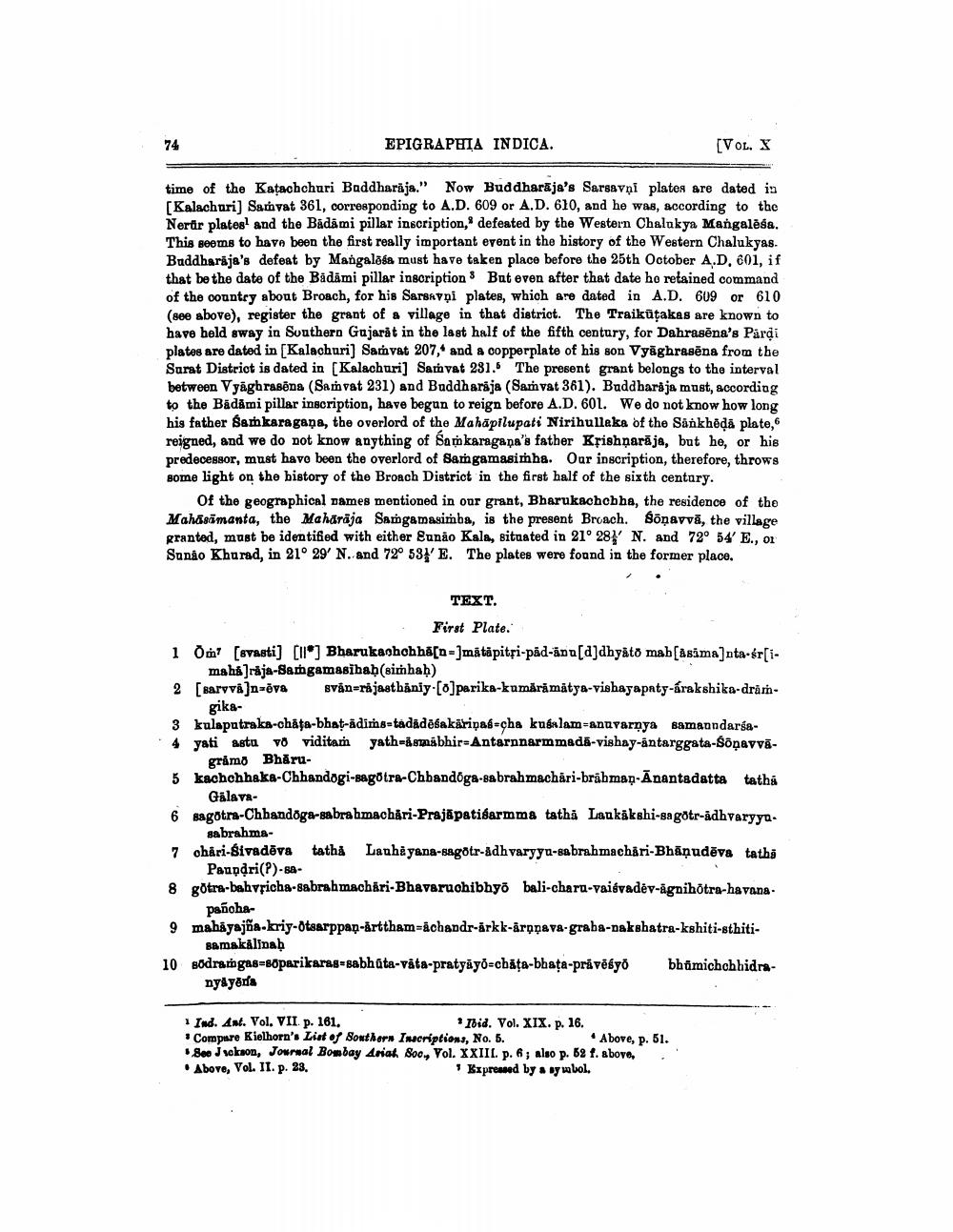________________
EPIGRAPHIA INDICA.
[VOL. X
time of the Katachchuri Baddharaja." Now Buddharāja's Sarsavņi plates are dated in [Kalachuri) Samvat 361, corresponding to A.D. 609 or A.D. 610, and he was, according to the Nertir plates and the Badāmi pillar inscription, defeated by the Western Chalukya Mangalēśa. This seems to have been the first really important event in the history of the Western Chalukyas. Baddbarāja's defeat by Mangalēša must have taken place before the 25th October A.D, 601, if that be the date of the Bidāmi pillar inscription 8 But even after that date ho retained command of the country about Broach, for his Sarsavội plates, which are dated in A.D. 609 or 610 (see above), register the grant of a village in that district. The Traikūtakes are known to have held away in Southern Gujarat in the last half of the fifth century, for Dahragēna's Pardi plates are dated in (Kalachuri) Samvat 207, and a copperplate of his son Vyāghrasēna from the Surat District is dated in (Kalachuri] Samvat 281. The present grant belongs to the interval between Vyaghrasēna (Saṁvat 231) and Buddharaja (Samvat 361). Baddbaraja must, according to the Badāmi pillar inscription, have begun to reign before A.D. 601. We do not know how long his father Samkaragaņa, the overlord of the Mahāpilupati Nirihulleka of the Sünkhoda plate, reigned, and we do not know anything of Sam karagana's father Krishnarāja, but he, or his predecessor, must have been the overlord of Samgamasinha. Our inscription, therefore, throws some light on the bistory of the Broach District in the first half of the sixth century.
Of the geographical Dames mentioned in our grant, Bharukachcbha, the residence of the Mahäsämanta, the Maharaja Samgamasimba, is the present Broach. Soņayvā, the village granted, must be identified with either Sunão Kala, situated in 21° 28' N. and 72° 54' E., OL Sunao Khurad, in 21° 29' N. and 72° 53' E. The plates were found in the former place.
TEXT.
First Plate. i om? (svasti] [11*] Bharukashohhäcn-]mātāpitri-päd-än u[]dhyāto mah (Asima]nta-śr[i
mahá]raja-Samgamasibah(simhab) 2 [Barvva]n-ova sván=rajasthaniy.[o]parika-kumärämätya-vishayapaty-árakshika-dram
gika3 kulapatraka-châta-bhat-ådims-tadadēšakäripal=cha kuslam-anavarnya samanndarsa4 yati astu vo viditam yath=smabhir-Antarnnarmmadā-vishay-antarggata-śāņavvā
gråmo Bhāru5 kachchhaka-Chhandogi-sagotra-Chbandöga-sabrahmachari-brāhmaṇ-Anantadatta tatha
Gálava6 sagotra-Chhandoga-sabrahmachåri-Prajāpatisarmma tatha Laukākshi-sagotr-adhvaryya.
sabrahma7 chåri-sivadēva tathả Lanhiyana-sagotr-adhvaryya-sabrahmachari-Bhāņudēva tathi
Panpdri(P)-888 götra-bahvricha-sabrahmachari-Bhavaruchibhyo bali-chara-vaisvadėvågnihotra-havana
pancha9 mahayajña-kriy-Otsarppan-arttham=chandr-arkk-ārņņava-graba-nakshatra-kshiti-sthiti
samakalina) 10 södraugas=soparikards=sabh ata-vita-pratyayo-chăța-bhata-právěsyo bhämichchhidra
nyiyada
Ind. Ant. Vol. VII. p. 161.
*Ibid. Vol. XIX. p. 16. Compare Kielhorn's List of Southern Inscriptions, No. 5.
Above, p. 51. See jsekson, Journal Bombay Aniah 800., Vol. XXIII. p. 6; also p. 62 f. above, Above, Vol. II. p. 33.
Expressed by any wol.




